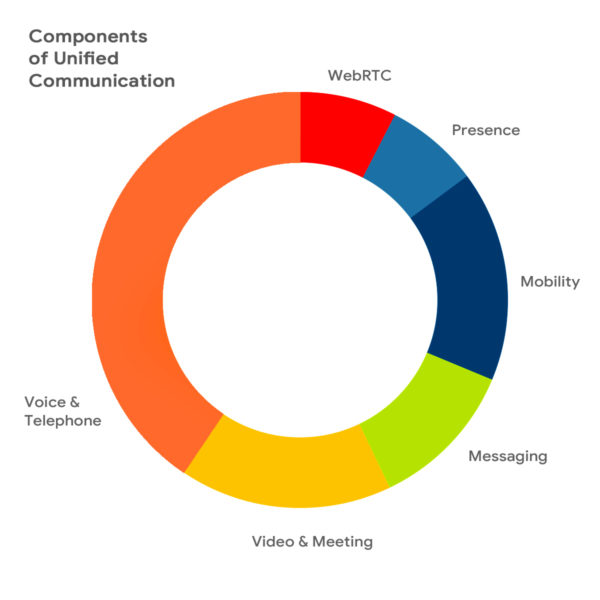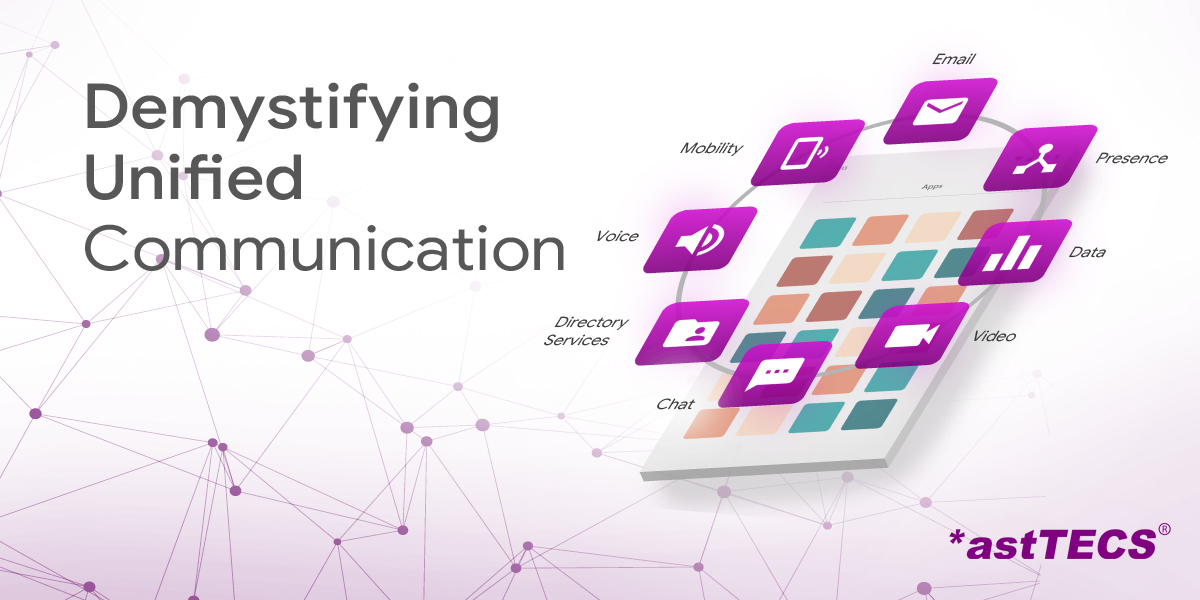What is Unified Communication?
In ancient times, drums and smoke signals were used to transmit messages in the forest. Early experiments with telegraph in 1809 marked the start of using technology in telecommunication. The famous first telephone conversation between Graham and Watson, where “Mr. Watson, come here, I want to see you” was transmitted, happened in 1876. The times to follow saw many technologies like telephone, SMS, Email, Video, and Messaging applications like WhatsApp, Messenger in the modern times, for communication in the private as well as business environment.
Businesses find it very efficient to have platforms, which could support multiple communication forms, and enable mixed forms of communication. Some examples are:
- Customer sending an SMS and receiving a call from the agent.
- Customer sending a missed call and receiving a video on WhatsApp.
- A voice message transcripted and send as an email.
- A email being readout as a voice message.
This resulted in emergence of versatile platforms supporting multiple communication technologies under the umbrella Unified Communication. The underlying principle was to use the technology best suited for each purpose. Unified Communication Platforms supported multiple forms of Communication and cross talks between them.
However, the definition of the UC platform remained ambiguous, as each supplier defined it, not in terms of his customer requirements, but his own capabilities.
How UC works?
The UC platform has an IP core enabling switching between different media streams/communication modes. The platform is connected to Multiple Gateways, which convert the native media streams to IP streams. Examples are SMS-Gateways, which convert SMS to a text message transported over IP, or GSM-Gateways, which converts GSM voice to RTP packets.
The IP Core is capable of making the necessary conversions and transporting to the other media/ communication mode.
Currently, each vendor is defining UC based on their capabilities. However, the customer requires a seamless integration of all communication channels into their organizational workflow. In other words, communication has to become a part of the IT infrastructure, and converge into one with the IT infrastructure. So, currently UC is a moving target with increasing capabilities.
Components of UC:
A typical UC Solution should support one or many of the following communication methods:

- Voice and Telephony: Telephony is one of the first forms of communication after drums, pigeons and bottles (written messages in sealed bottles ). Telephone calls between two participants, and voice messages in the absence of one participant, IVR menus etc are the important applications in this area. Combinations thereof in an UC scenario, are upgrading the conversation to Video Calling, sending SMS based on the disposition after the call is terminated, sending Videos after call ends etc.
- Video and Meeting Solutions: Video conferencing is gaining popularity as a substitute to physical meeting. These solutions are equipped with much more than just seeing the real-time image of other party and then talking. They are capable of uploading presentations, white-board, playing videos etc, and thereby creating an all inclusive experience of being physically in the same room.
- Messaging: Messaging has gained much popularity considering it’s non-intrusive nature. In case of telephone, the communication happens at the time and convenience of the sender and not the receiver. In case of messaging, the user may choose to read the message at her convenience and also respond to it at her convenience.
- Presence: Presence indicates, if the user is available and if so through which channel. If the user is attending a conference, he might prefer to communicate through WhatsApp and not take any phone calls. This feature helps the user to signal his availability to the outside world, and also enable only those channels, which the customer wishes to.
- Mobility: Mobiles are becoming ‘THE’ device for any type of communication. So, any form of UC should be supported mobile devices, and also the various modes with which they can connect to the platform.
- WebRTC: Voice or video communication requires special gadgets like a hard phone, or phone equipped with Camera, Color display etc, which hampers the usage anywhere, anytime. Parallely, Browsers have developed to a technology, which is available in many devices like laptops, desktops, tabs, mobiles etc. In simple terms, a software phone in a browser is WebRTC. This technology helps the users to carry out real-time communication from any browser, and thereby eliminates the need for any special device.
A careful selection of the above options and seamless integration of them into the enterprise business processes will be a differentiator for the enterprises of next generation.
Benefits of UC:
Voice Communication in enterprises was pre-dominantly carried out on EPABX platforms. With the advent of mobile phones and IP communication, the trend moved towards one-to-one communication from mobile application or softphones. The advent of Unified Communication and seamless integration into enterprise applications brought back the focus on a centralized Unified Communication platform. UC helps employees to communicate more effectively, and thereby saving time and money, and also results in a higher productivity. The multiple benefits of usage of Unified Communication Platform in enterprises are:
- Streamline Business Process: Business process encompasses multiple departments and effective communication between these departments are necessary for the implementation of an effective business process. Also, business process involves effective communication with the customers, who may be reached through various forms like voice, video, message etc.
- Improved Efficiency & Productivity: The mixing and matching of different communication channels ensures an optimal combination of communication channels, and thereby achieving an effective communication. The obvious result is the increase in productivity.
- Reduced Costs: Travel costs are reduced drastically by effective usage of audio, video conferences. Also, with availability of multiple media for communication, the cost-effective media can be used at each stage.
- Better Customer Service: Customers can avail support services through multiple channels like voice, email, chat etc. Also, responses can be made available through the most effective media, which improves the customer service experience. Customers complaining of long waiting queues can engage with chat bots to register their complaints faster.
- Enables mobile & remote workforce: Mobile and Remote workforce are integrated into the enterprise communication in the UC platform.
- Improved Security: The UC platforms come with multiple inbuilt security mechanisms.
The benefits of UC platforms are multitude and we see that every day new pardigms are evolving, which introduces even more effective processes based on UC.
Implementation Trends:
Deployment of UC can happen in servers located in the premises, or in the Cloud.
- Premise based Unified Communication Server: Many of the premise based EPABX are getting upgraded to UC based systems. The installed base of UC capable EPABX, are estimated to be around USD 200 Billion. An estimated 10% of the customers gets upgraded every year and another 8% of new additions. Customers from large enterprises consider business communication as part of their confidential data and therefore are very reluctant to move it outside their office.
- Unified Communication as a Service: Latest trends indicate that a good number of customers are comfortable to move their systems to Cloud based Servers, especially the new additions. As security measures are improving, and also the infrastructure, an added interest is being seen in adoption of cloud software.
A co-existence with Cloud growing at a faster rate is being predicted for the near future. However, it might take another decade for the Cloud base share to reach near the premise based installations. The Cloud providers need to ensure high security features to make this possible in the predicted time period.
Future of UC (Trends in UC):
Intelligent UC is the Mantra for the future. The promises of Artificial intelligence and its penetration to all domains presents an opportunity for UC to become more smart.

- Analytics: Communication to the customer is the key to the relationship to the customer. So measurement and evaluation of the contact parameters will become an ingredient of effective UC. This could start from the phase of lead generation, where the effectiveness various channels like voice blasting, bulk emailing or bulk messaging is measured and analysed. For example, measuring how many leads came out of a particular region for a particular campaign and then planning similar campaigns in the same region. This analysis and planning can go up to sales support and after sales support.
- Natural Language Processing: As UC permeates in all pockets of the enterprise, a well accepted and easy to use interface is a must. Natural language is the interface, which can be used by all levels from Managers to sweepers in an organisation. Recent advances in Speech Recoginition/NLP (Natural language processing), especially using Deep Learning Techniques, makes it the natural choice for the next level interface.
- Artificial Intelligence: Intelligent Systems fuelled by Artificial Intelligence are today’s Mantra. The development of cheap computing power and modern algorithms like Deep Learning accelerated the usage of AI in all domains. The usage of AI in UC scenarios leads to a much more effective organisation management.
- 5G Connectivity: The backbone of everything in UC is a ubiquitous, reliable IP network. 5G promises exactly that. Most of the carriers have started the field trails and we can expect a wide-spread rollout in the next 2 years.
Migration to an UC environment is an unquestioned strategy for any business in the current decade. A careful study of the business requirement and the UC tools required is a necessity for any business. The study should outline the UC requirements to select the right vendor and deployment strategy among the multiple options available. The transformation of EPABX to UC platform opens up tremendous opportunities as well as challenges to suppliers, as well as customers in this domain.




Leave A Comment